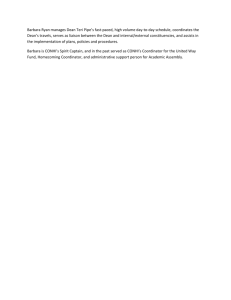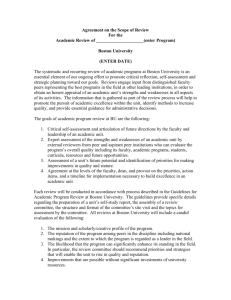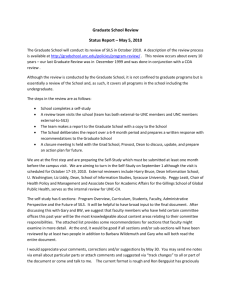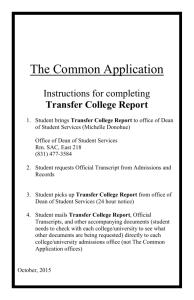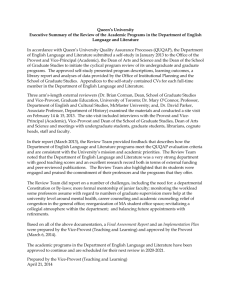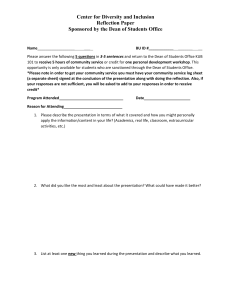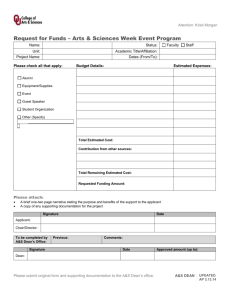Procedures and Guidelines for Review of Academic Programs
advertisement
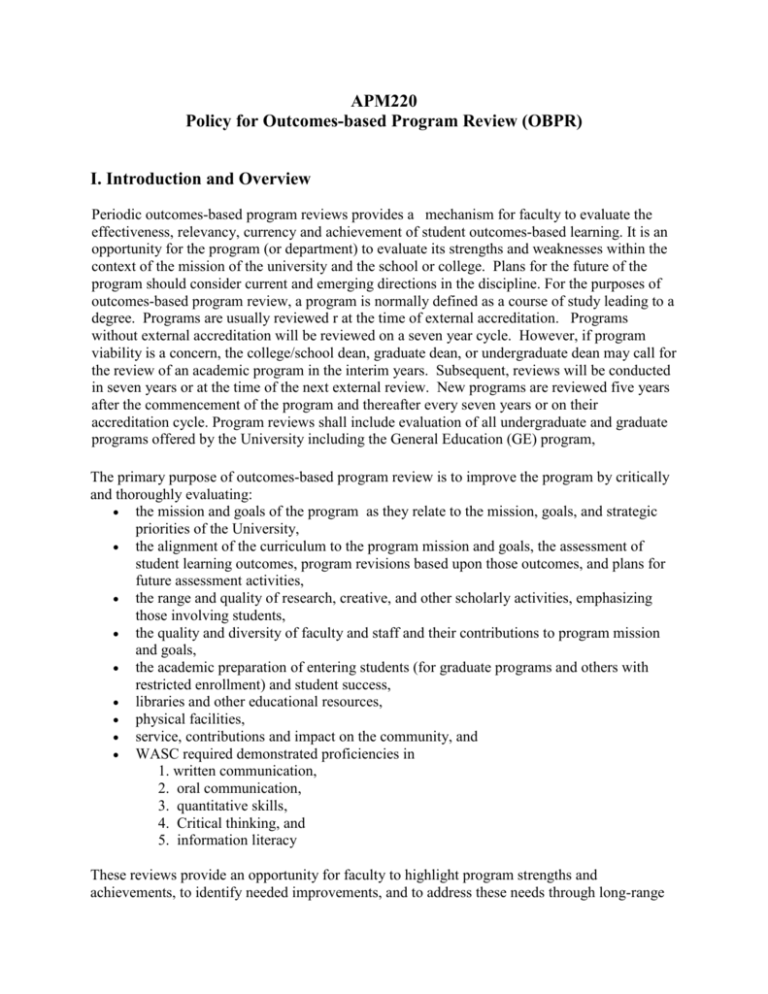
APM220 Policy for Outcomes-based Program Review (OBPR) I. Introduction and Overview Periodic outcomes-based program reviews provides a mechanism for faculty to evaluate the effectiveness, relevancy, currency and achievement of student outcomes-based learning. It is an opportunity for the program (or department) to evaluate its strengths and weaknesses within the context of the mission of the university and the school or college. Plans for the future of the program should consider current and emerging directions in the discipline. For the purposes of outcomes-based program review, a program is normally defined as a course of study leading to a degree. Programs are usually reviewed r at the time of external accreditation. Programs without external accreditation will be reviewed on a seven year cycle. However, if program viability is a concern, the college/school dean, graduate dean, or undergraduate dean may call for the review of an academic program in the interim years. Subsequent, reviews will be conducted in seven years or at the time of the next external review. New programs are reviewed five years after the commencement of the program and thereafter every seven years or on their accreditation cycle. Program reviews shall include evaluation of all undergraduate and graduate programs offered by the University including the General Education (GE) program, The primary purpose of outcomes-based program review is to improve the program by critically and thoroughly evaluating: the mission and goals of the program as they relate to the mission, goals, and strategic priorities of the University, the alignment of the curriculum to the program mission and goals, the assessment of student learning outcomes, program revisions based upon those outcomes, and plans for future assessment activities, the range and quality of research, creative, and other scholarly activities, emphasizing those involving students, the quality and diversity of faculty and staff and their contributions to program mission and goals, the academic preparation of entering students (for graduate programs and others with restricted enrollment) and student success, libraries and other educational resources, physical facilities, service, contributions and impact on the community, and WASC required demonstrated proficiencies in 1. written communication, 2. oral communication, 3. quantitative skills, 4. Critical thinking, and 5. information literacy These reviews provide an opportunity for faculty to highlight program strengths and achievements, to identify needed improvements, and to address these needs through long-range plans that will endure through short-term administrative changes or budget crises. OBPR is integral to student learning, planning, resource allocation, and other decision-making activities that support the university. Regular program reviews also allow the university to account publicly for its use of public resources and to develop support among its various constituencies. At California State University, Fresno, the Dean of the Division of Graduate Studies, or designee, serves as the review officer for graduate programs and the Dean of Undergraduate Studies, or designee, as the review officer for undergraduate programs. II. Elements of Program Review In order to allow for reflection and input, the OBPR process is thoughtful, well-planned and comprehensive. The department chair, program coordinator, and/or the appropriate faculty first prepare a plan for outcomes-based program review and subsequently a self-study for each program under review. An external review panel examines the self-study, visits the program, and prepares a report. The department and dean are afforded the opportunity to comment on the review panel’s report. The report and comments are forwarded to the appropriate university-level committee for review. After receiving committee recommendations, the program or department writes an action plan in response to those recommendations . An action plan meeting is held in which the program coordinator, department chair, college/school dean, and members of the Academic Affairs administration agree upon priorities and resources for a final action plan. A. Outcomes-based Program Review Planning The planning process of an OBPR will include: Guidance by the program review coordinator who is responsible for the coordination and oversight of the review process Establishment of a timeline for completing tasks Development of guiding questions in each of the following categories: 1. Program Objectives/Outcomes 2. Student Outcomes 3. Program Demand and Sustainability 4. Program Infrastructure (Capacity) 5. Program Trajectory (Future Viability) Determination of the measurements, instruments, and data collection timeframes B. Outcomes-based Annual Report A critical part of the outcomes-based program review cycle includes an annual report that details the agreed upon measures related to the guiding questions Data for each calendar year shall be gathered and presented for the following categories: 1. Student learning outcomes, 2. Follow-up on “closing the loop” activities or measures from the prior cycle Data for the prior calendar year shall be gathered and reported no later than June of the preceding year. (e.g., data for January 1, 2012 – December 31, 2012 shall be reported by the end of May, 2013). C. Outcomes-based Self-Study The self-study is a comprehensive written report examining the academic program scheduled for review. The self-study is prepared by the department chair, program coordinator, and/or the appropriate faculty members. For accredited programs, the self-study is the report prepared for the accrediting body with a supplement containing the information in Section A, items 1-5 above if that information is not in the report required by the accrediting agency . If the department undergoing review has multiple degrees, a separate self-study shall be prepared for each degree, although a common set of supporting materials may be included in multiple reports. The self-study examines the current status of the academic program based on: 1. Program Objectives/Outcomes, 2. Student Outcomes, 3. Program Demand and Sustainability a. State of Field / Discipline b. Employment Opportunities (current and future) c. Post-Graduate Opportunities 4. Program Infrastructure (Capacity) a. Facilities b. Student Faculty Ratios c. Staff Support d. Other Resources 5. Program Trajectory (Current Status and Future Viability) Recommendations for program improvement, a plan to implement those recommendations, and methods for measuring progress towards goal achievement should be included. The college/school dean will review the program’s self-study, provide comments and work with the department to address any concerns that emerge. D. Site Visit and Report by a Panel of External Reviewers A site visit will be conducted by a team of at least three reviewers including an external expert in the discipline under review who has experience with student outcomes assessment in that discipline, a faculty member from within the school or college of the department, and a faculty member from the campus but outside the school or college of the department. The department, in consultation with the dean, nominates members of the team and the dean approves the nominees. For accredited programs, the composition of the team may be mandated by the accrediting agency. The team drafts a report summarizing their findings and recommendations then presents the draft report to the department, school/college and university prior to the end of the visit. The team submits a final written report to the school/college dean within two weeks of the visit. E. Responses to the Team Report The department chair, in consultation with the program coordinator and/or appropriate faculty members provides a written response to the team report. This response addresses issues raised in the report and may also discuss significant changes or developments that have taken place in the program subsequent to the self-study. The departmental response is submitted to the college/school dean. . The college/school dean responds in writing to the issues raised in the reviewers’ report and also addresses the departmental response. The dean’s and department’s responses are submitted to the appropriate university review officer(s). F. University Committee Review The appropriate Academic Senate committees examine the external reviewer’s report and the department’s and dean’s responses. The Academic Senate program review committees may interview representatives of the program and the administration as appropriate. The Academic Senate program review committees comment on the outcomes-based program review process in the department and they make one of the following recommendations: 1. Approve a Program with Notation of Exceptional Quality. Approval is recommended without reservation and with a notation of specific areas of program promise and excellence. Programs recommended in this category may be considered for an award for program excellence. These are programs that exhibit special strength in all aspects of the review process and reflect the very best attributes of commitment, quality, and promise. 2. Approve a Program for Continuation. Program approval is recommended with identification of specific areas that need to be further developed, and a notation of specific areas of achievement. These programs meet most evaluative measures of quality, but nonetheless could improve in substantial ways (e.g., absence of a strong student recruitment plan or incomplete implementation of learning outcomes assessment.) 3. Approve a Program for Conditional Continuation. Conditional approval is recommended with identification of specific areas requiring significant improvement, including the conditions and a reasonable time frame for such conditions to be met in achieving unconditional approval. Conditional continuation is appropriate for a program that fails to meet expected quality standards and for which additional time and/or implementation of planned actions to address these weaknesses could be expected to eliminate such deficiencies without impairing student progress (e.g., the need to obtain faculty, space or equipment, or implement learning outcomes assessment.) 4. Suspend a Program. A recommendation for suspension of a program is appropriate upon receipt of a conditional continuation in the most recent program review and when two conditions occur: (1) when the program fails to meet established standards of quality that insure an appropriate academic experience for students and (2) when there is evidence that these deficiencies may be corrected over a specified period of time. Recommendation to suspend a program could lead to administrative action which: (1) places a moratorium on new student admissions; (2) requires students currently in the program be accommodated so that they may complete the program; (3) places a moratorium on reappointment of faculty to graduate faculty status, if pertinent to a graduate program; and (4) removes program catalog copy. The degree title may be retained on the trustee-approved campus Academic Plan. If evidence suggests that the program may be successfully reconstituted at a later date, then conditions to be fulfilled in order to fully reopen the program should be identified along with a process to support the removal of a recommendation for suspension. Note that discontinuation may result if the program is unable to satisfy the conditions for successful reconstitution as identified. 5. Discontinue a Program. A recommendation to discontinue a program is appropriate upon receipt of a conditional continuation in the most recent program review and when the program fails to meet established standards of quality that insure an appropriate academic experience for students, and at the same time when there is no evidence that deficiencies have been corrected over a specified period of time. Recommendation to discontinue a program could lead to administrative action which: (1) places a moratorium on new student admissions; (2) requires students currently in the program be accommodated so that they may complete the program; (3) places a moratorium on reappointment of faculty to graduate faculty status, if pertinent; and (4) removes program catalog copy. A separate process for review of the implications of program termination is implemented. This second and separate level of review follows University policy and includes an assessment of the implications for the University and its service area, faculty, facilities, students, and resources if the program is discontinued. G. The Action Plan and Follow-up The department chair, and/or the appropriate faculty members, in consultation with the dean and the program coordinator, drafts an action plan based on the report and recommendations. The draft action plan is sent to the appropriate university review officer. The Provost will call a meeting to discuss the draft action plan. This meeting will establish priorities within the action plan and identify resources needed to achieve these goals. Each year a progress report on the items in the action plan will be included in the Department Chair’s Annual Report to the Provost. The Provost shall acknowledge commendable outcomes-based program reviews at the annual Provost Awards for Excellence ceremony.

